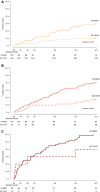Comorbidities may offset expected improved survival after transcatheter aortic valve replacement
- PMID: 35919341
- PMCID: PMC9242031
- DOI: 10.1093/ehjopen/oeac029
Comorbidities may offset expected improved survival after transcatheter aortic valve replacement
Abstract
Aims: After transcatheter aortic valve replacement (TAVR), cardiovascular and non-cardiovascular comorbidities may offset the survival benefit from the procedure. We aimed to describe the relationships between that benefit and patient comorbidities.
Methods and results: The study pooled two European cohorts of patients with severe aortic stenosis (AS-pooled): one with patients who underwent (cohort of AS patients treated by TAVR, N = 233) and another with patients who did not undergo TAVR (cohort of AS patients treated medically; N = 291). The investigators collected the following: calcification prognostic impact (CAPRI) and Charlson scores for cardiovascular and non-cardiovascular comorbidities, activities of daily living (ADL)/instrumental activities of daily living (IADL) scores for frailty as well as routine Society of Thoracic Surgeons (STS) score and Logistic Euroscore. Unlike ADL/IADL scores, CAPRI and Charlson scores were found to be independent predictors of 1-year all-cause death in the AS-pooled cohort, with and without adjustment for STS score or Logistic Euroscore; they were thus retained to define a three-level prognostic scale (good, intermediate, and poor). The survival benefit from TAVR-vs. no TAVR-was stratified according to these three prognosis categories. The beneficial effect of TAVR on 1-year all-cause death was significant in patients with good and intermediate prognosis, hazard ratio (95% confidence interval): 0.36 (0.18; 0.72) and 0.32 (0.15; 0.67). That effect was reduced and not statistically significant in patient with poor prognosis [0.65 (0.22; 1.88)].
Conclusion: The study showed that, beyond a given comorbidity burden (as assessed by CAPRI and Charlson scores), the probability of death within a year was high and poorly reduced by TAVR. This indicates the futility of TAVR in patients in the poor prognosis category.
Keywords: Comorbidities; Medical futility; Mortality; Organ dysfunction scores; Transcatheter aortic valve replacement.
© The Author(s) 2022. Published by Oxford University Press on behalf of the European Society of Cardiology.
Figures






References
-
- Baumgartner H, Falk V, Bax JJ, De Bonis M, Hamm C, Holm PJ, Iung B, Lancellotti P, Lansac E, Rodriguez Muñoz D, Rosenhek R, Sjögren J, Tornos Mas P, Vahanian A, Walther T, Wendler O, Windecker S, Zamorano JL, Roffi M, Alfieri O, Agewall S, Ahlsson A, Barbato E, Bueno H, Collet J-P, Coman IM, Czerny M, Delgado V, Fitzsimons D, Folliguet T, Gaemperli O, Habib G, Harringer W, Haude M, Hindricks G, Katus HA, Knuuti J, Kolh P, Leclercq C, McDonagh TA, Piepoli MF, Pierard LA, Ponikowski P, Rosano GMC, Ruschitzka F, Shlyakhto E, Simpson IA, Sousa-Uva M, Stepinska J, Tarantini G, Tchétché D, Aboyans V, Windecker S, Aboyans V, Agewall S, Barbato E, Bueno H, Coca A, Collet J-P, Coman IM, Dean V, Delgado V, Fitzsimons D, Gaemperli O, Hindricks G, Iung B, Jüni P, Katus HA, Knuuti J, Lancellotti P, Leclercq C, McDonagh T, Piepoli MF, Ponikowski P, Richter DJ, Roffi M, Shlyakhto E, Simpson IA, Zamorano JL, Kzhdryan HK, Mascherbauer J, Samadov F, Shumavets V, Camp GV, Lončar D, Lovric D, Georgiou GM, Linhartova K, Ihlemann N, Abdelhamid M, Pern T, Turpeinen A, Srbinovska-Kostovska E, Cohen A, Bakhutashvili Z, Ince H, Vavuranakis M, Temesvári A, Gudnason T, Mylotte D, Kuperstein R, Indolfi C, Pya Y, Bajraktari G, Kerimkulova A, Rudzitis A, Mizariene V, Lebrun F, Demarco DC, Oukerraj L, Bouma BJ, Steigen TK, Komar M, De Moura Branco LM, Popescu BA, Uspenskiy V, Foscoli M, Jovovic L, Simkova I, Bunc M, de Prada JAV, Stagmo M, Kaufmann BA, Mahdhaoui A, Bozkurt E, Nesukay E, Brecker SJD. 2017. ESC/EACTS Guidelines for the management of valvular heart disease. Eur Heart J 2017;38:2739–2791. - PubMed
-
- Puri R, Iung B, Cohen DJ, Rodes-Cabau J. TAVI or No TAVI: identifying patients unlikely to benefit from transcatheter aortic valve implantation. Eur Heart J 2016;37:2217–2225. - PubMed
-
- Gilard M, Eltchaninoff H, Iung B, Donzeau-Gouge P, Chevreul K, Fajadet J, Leprince P, Leguerrier A, Lievre M, Prat A, Teiger E, Lefevre T, Himbert D, Tchetche D, Carrié D, Albat B, Cribier A, Rioufol G, Sudre A, Blanchard D, Collet F, Santos PD, Meneveau N, Tirouvanziam A, Caussin C, Guyon P, Boschat J, Le Breton H, Collart F, Houel R, Delpine S, Souteyrand G, Favereau X, Ohlmann P, Doisy V, Grollier G, Gommeaux A, Claudel J-P, Bourlon F, Bertrand B, Van Belle E, Laskar M. Registry of transcatheter aortic-valve implantation in high-risk patients. N Engl J Med 2012;366:1705–1715. - PubMed
-
- Durand E, Borz B, Godin M, Tron C, Litzler PY, Bessou JP, Dacher J-N, Bauer F, Cribier A, Eltchaninoff H. Performance analysis of EuroSCORE II compared to the original logistic EuroSCORE and STS scores for predicting 30-day mortality after transcatheter aortic valve replacement. Am J Cardiol 2013;111:891–897. - PubMed
-
- Ludman PF, Moat N, de Belder MA, Blackman DJ, Duncan A, Banya W, MacCarthy PA, Cunningham D, Wendler O, Marlee D, Hildick-Smith D, Young CP, Kovac J, Uren NG, Spyt T, Trivedi U, Howell J, Gray H. Transcatheter aortic valve implantation in the United Kingdom. Circulation 2015;131:1181–1190. - PubMed
LinkOut - more resources
Full Text Sources
Research Materials

